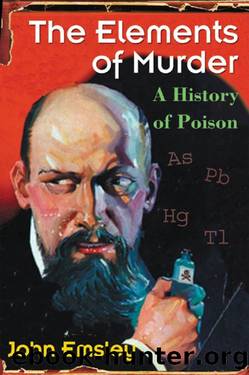Elements of Murder, The: A History of Poison by Emsley John;

Author:Emsley, John;
Language: eng
Format: epub
Publisher: Oxford University Press
Published: 2012-12-12T00:00:00+00:00
Antimony has its uses
Antimony is not quite a true metal â chemists refer to it as a metalloid or semi-metal, meaning it has both metallic and non-metallic properties. In its metallic form it resembles lead, with which it can be alloyed, and these alloys account for most of its modern usage, being the electrode plates in motor vehicle batteries. Antimony imparts strength and hardness and it is also added in small amounts to the brass used to cast bells. When lead-based pewter fell out of favour, it was replaced by an alloy of 89% tin, 7% antimony, 2% copper, and 2% bismuth. Other products made of lead such as bullets, lead shot, and cable sheathing, are still hardened with a few percent of antimony. The antimony in bullets can be used to identify them, as we shall see in the next chapter.
Babbitt metal was patented by Isaac Babbitt in 1839, although the term is now applied to a range of silver-white alloys with remarkable anti-friction properties. All contain antimony. They consist of relatively hard alloy crystals embedded in a matrix of softer metal and are ideal for machine bearings, so they are used in gas turbines, electric motors, and pumps. Some are lead-based and typically contain 15% antimony, plus small amounts of tin and arsenic, while others are tin-based and have around 7% antimony with small amounts of copper and lead. The alloy is cast on to the metal surface, or it can even be sprayed on by means of a flame arc gun. Babbitt metal is used when there is likely to be incomplete separation between a stationary surface and a moving part. The Babbitt metal quickly adapts its shape to the moving part so that there is less friction between the surfaces and the lubricating oil spreads evenly between the two metals. This leads to fewer hot spots and less likelihood of enough heat being generated to cause the metals to weld together.
Antimony compounds were once used in industry more widely than they are now; for example antimony potassium tartrate was employed in the tanning and textile industries as a mordant, which is the fixing agent needed for dyeing leather and fabrics. The antimony binds chemically to the surface of fibres and the dye binds chemically to the antimony. Nowadays aluminium in the form of aluminium potassium sulphate has replaced antimony as a mordant. Other antimony compounds are still used in certain types of glass and ceramics, pigments, and semiconductors such as gallium arsenide antimonide. Antimony sulphide is needed for medical scintigraphy equipment, which uses radioisotopes and a scintillation counter to get an image of a body organ.
Antimony is an important metal in the world economy. Annual production in 2003 was 140000 tonnes, and 90% of this came from China, whose reserves are in excess of a million tonnes. The chief ores are stibnite and tetrahedrite (a copper, iron, antimony sulphide mineral) which yields antimony as a by-product. On the world market antimony costs about $1/pound (which is around $2400 per tonne).
Download
This site does not store any files on its server. We only index and link to content provided by other sites. Please contact the content providers to delete copyright contents if any and email us, we'll remove relevant links or contents immediately.
Alchemy and Alchemists by C. J. S. Thompson(3359)
The Elements by Theodore Gray(2899)
The Club by A.L. Brooks(2783)
How to Make Your Own Soap by Sally Hornsey(2766)
Drugs Unlimited by Mike Power(2496)
Wheels of Life by Anodea Judith(1936)
Cracking the Sat French Subject Test, 2013-2014 Edition by The Princeton Review(1784)
Perfume by Jean-Claude Ellena(1748)
The Flavor Matrix by James Briscione(1729)
Cracking the LSAT, 2012 Edition by Princeton Review(1725)
The Cosmic Machine: The Science That Runs Our Universe and the Story Behind It by Scott Bembenek(1699)
MCAT Physics and Math Review by Princeton Review(1583)
1000 Multiple-Choice Questions in Organic Chemistry by Organic Chemistry Academy(1575)
The Thing Around Your Neck by Chimamanda Ngozi Adichie(1521)
Handbook of Modern Sensors by Jacob Fraden(1502)
Cracking the SAT Premium Edition with 6 Practice Tests, 2017 by Princeton Review(1489)
Synchrotron Light Sources and Free-Electron Lasers by Eberhard J. Jaeschke Shaukat Khan Jochen R. Schneider & Jerome B. Hastings(1481)
A is for Arsenic: The Poisons of Agatha Christie (Bloomsbury Sigma) by Kathryn Harkup(1466)
Harry Potter All Books: 8 Books by J.k.rowling(1448)
